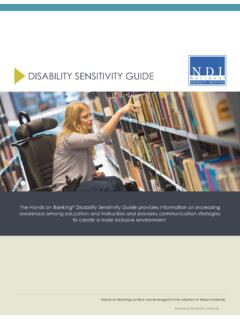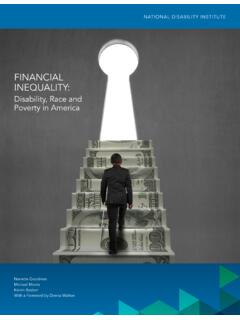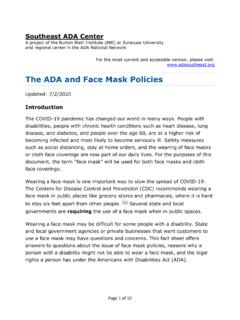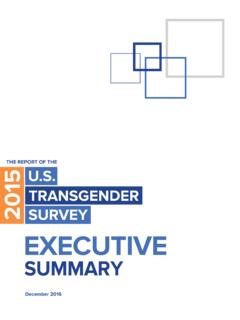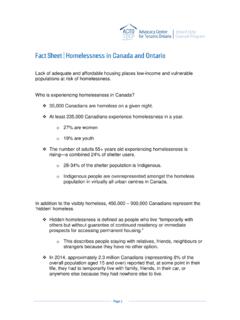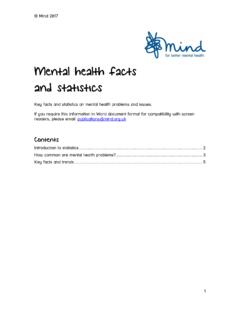Transcription of Race, Ethnicity and Disability
1 Race, Ethnicity and Disability : The Financial Impact of Systemic Inequality and Intersectionality National Disability Institute, August 2020 The Moment of Today Today, the is facing two concurrent crises, the COVID-19 pandemic and widespread recognition of historic and systemic racism that disproportionately impact Americans that are Black, Indigenous and people of Color (BIPOC). COVID-related hospitalization rates for non-Hispanic, Black and Indigenous persons are five times that of non-Hispanic white persons. The Latinx community comes in at a close third, with hospitalization rates four times that of non-Hispanic white Additionally, Black-owned businesses experienced more difficulty receiving money from the $349 billion government stimulus Ahmad Aubrey, George Floyd and Breonna Taylor are part of a far-too-long list of murdered Black Americans whose names are being chanted in protests across the country.
2 These protests continue to raise awareness on the dangers of systemic racism on Black Americans and communities of color. The country is experiencing a crisis in this moment when Black Americans are three times as likely to die at the hands of police and times as likely to die at the hands of COVID-19 than white 1 Coronavirus Disease 2019: Health Equity Considerations and Racial and Ethnic Minority Groups, Centers for Disease Control and Prevention, last modified June 25, 2020, 2 Emily Flitter, Black-Owned Businesses Could Face Hurdles in Federal Aid Program, New York Times, April 10, 2020, 3 Ariana Eunjung Cha, We don t get justice.
3 When a black girl s death from covid-19 feels like a collision of two crises, Washington Post, June 6, 2020, 2 These injustices also unduly affect Americans with disabilities. In relation to the pandemic, individuals with disabilities are overly represented in the lives lost due to Those that remain healthy have been disproportionately affected by job loss, where 20 percent of people with disabilities working in January were out of work in May. Among BIPOC Americans with disabilities, 35 percent lost their jobs. For some individuals, discrimination based on race and Disability significantly affect their lives in a myriad of ways. BIPOC Americans with disabilities face unique systemic challenges as a result of their intersecting identities.
4 Michael Hickson, a Black man with quadriplegia, recently died of COVID-19 when doctors decided to terminate treatment, doubtful that, if he did survive, he would have much of a quality of life. 5 Marcus-David Peters, another Black man with a Disability , was shot and killed by police during a psychiatric Both of these stories highlight examples of people with the least power and least access to resources being left unprotected. 7 Systemic injustices lead to economic inequality. A recent poll shows that 76 percent of Americans today agree that racial discrimination is a big problem in As we reflect on the advances achieved, based on the passage of the Americans with Disabilities Act (ADA) 30 years ago, we are more aware than ever before of the promise of this groundbreaking legislation to promote economic self-sufficiency for individuals with disabilities.
5 This promise must cover ALL individuals with disabilities regardless of race, Ethnicity , gender and sexual orientation. 4 Stephen Frost, Deadly Discrimination: The Forgotten Impact Of Covid-19 On people With Disabilities, Forbes, July 6, 2020 #68ea90ae2b93. 5 Ariana Eunjung, Quadriplegic man s death from covid-19 spotlights questions of Disability , race and family, Washington Post, July 5, 2020, 6 Abigail Abrams, Black, Disabled and at Risk: The Overlooked Problem of Police Violence Against Americans with Disabilities, TIME Magazine, June 25, 2020, 7 Ariana Eunjung Cha, We don t get justice : When a black girl s death from covid-19 feels like a collision of two crises, Washington Post, June 6, 2020, 8 Giovanni Russonello, Why Most Americans Support the Protests, New York Times, June 5, 2020, 3 Historical Context for Understanding Intersectionality An individual s lived experience is greater than the sum of his or her identities.
6 Intersectionality, a term coined by legal scholar Kimberl Crenshaw, is a lens, a prism, for seeing the way in which various forms of inequality often operate together and exacerbate each other. 9 Crenshaw originally used the theory to explain the systemic discrimination against Black women, individuals who could not separate the women s experience from the Black experience , in a legal She uses the case Degraffenreid v. General Motors to support her argument. Prior to the year 1964, General Motors hired no Black women, but they did hire white women and Black men. After a new seniority policy led to the firing of all five Black women working in the company, the women had no legal grounds on which to base their suit.
7 In essence, the women could not say they were experiencing discrimination based on race alone or gender alone and, without the term intersectionality, there was no way to describe the unique form of systemic discrimination that affected their lives. Scholars in the field of sociology and philosophy have since expanded the intersectional conversation to include the Disability community. However, even though intersectionality is critical in understanding the diverse experiences of individuals with disabilities, little research has focused on how this intersectionality plays out in the economic Financial Impacts Centuries of exclusive practices in the United States, such as redlining and employment discrimination, have resulted in a society where people of color with disabilities, particularly BIPOC and the Latinx community, are at a particular disadvantage financially.
8 Building on the National Disability Institute (NDI) 2017 report, Financial Inequality: Disability , Race and Poverty in America, updated research on the financial conditions of individuals, grouped by Disability status and racial/ethnic identity, reflects that individuals who live at this intersection of race and Disability experience disproportionate levels of financial distress. 9 Katy Steinmetz, She Coined the Term Intersectionality Over 30 Years Ago. Here s What It Means to Her Today, TIME Magazine, February 20, 2020, 10 Kimberl Crenshaw, Demarginalizing the Intersection of Race and Sex: A Black Feminist Critique of Antidiscrimination Doctrine, Feminist Critique of Antidiscrimination Doctrine, Feminist Theory and Antiracist Politics, University of Chicago Legal Forum, 1989, no.
9 1 (1989): 139-167. 11 Angela Frederick and Dana Shifrer, Race and Disability : From Analogy to Intersectionality, Sociology of Race and Ethnicity , 5, no. 2 (2019): 200-214, 4 Poverty rate: Across all racial and ethnic groups, 26 percent of individuals with a Disability are living below the poverty line compared with 11 percent of individuals without a Disability . The poverty rate of BIPOC communities is higher than the rate of white communities regardless of Disability status. However, regardless of race and Ethnicity , individuals with disabilities are significantly more likely to be living in poverty than those without disabilities. The groups with the highest poverty rates are Black and Indigenous individuals with disabilities (Figure 1).
10 Figure 1: Poverty Rate of Working-age Population, by Race, Ethnicity and Disability Status, 2018 Source: NDI Analysis of Census Bureau. (2019). 2018 American Community Survey 1-year Public Use Microdata Sample. 5 Educational Level: Across all racial and ethnic groups, 35 percent of individuals without a Disability have a bachelor s degree or higher, while 15 percent of individuals with a Disability have similar educational attainment. Again, individuals with disabilities have lower levels of educational attainment within each racial/ethnic group, and all racial/ethnic minority groups have lower levels of educational attainment when compared to non-Hispanic white individuals.
